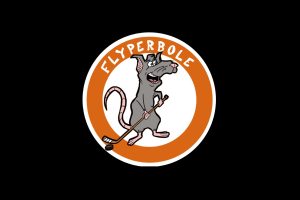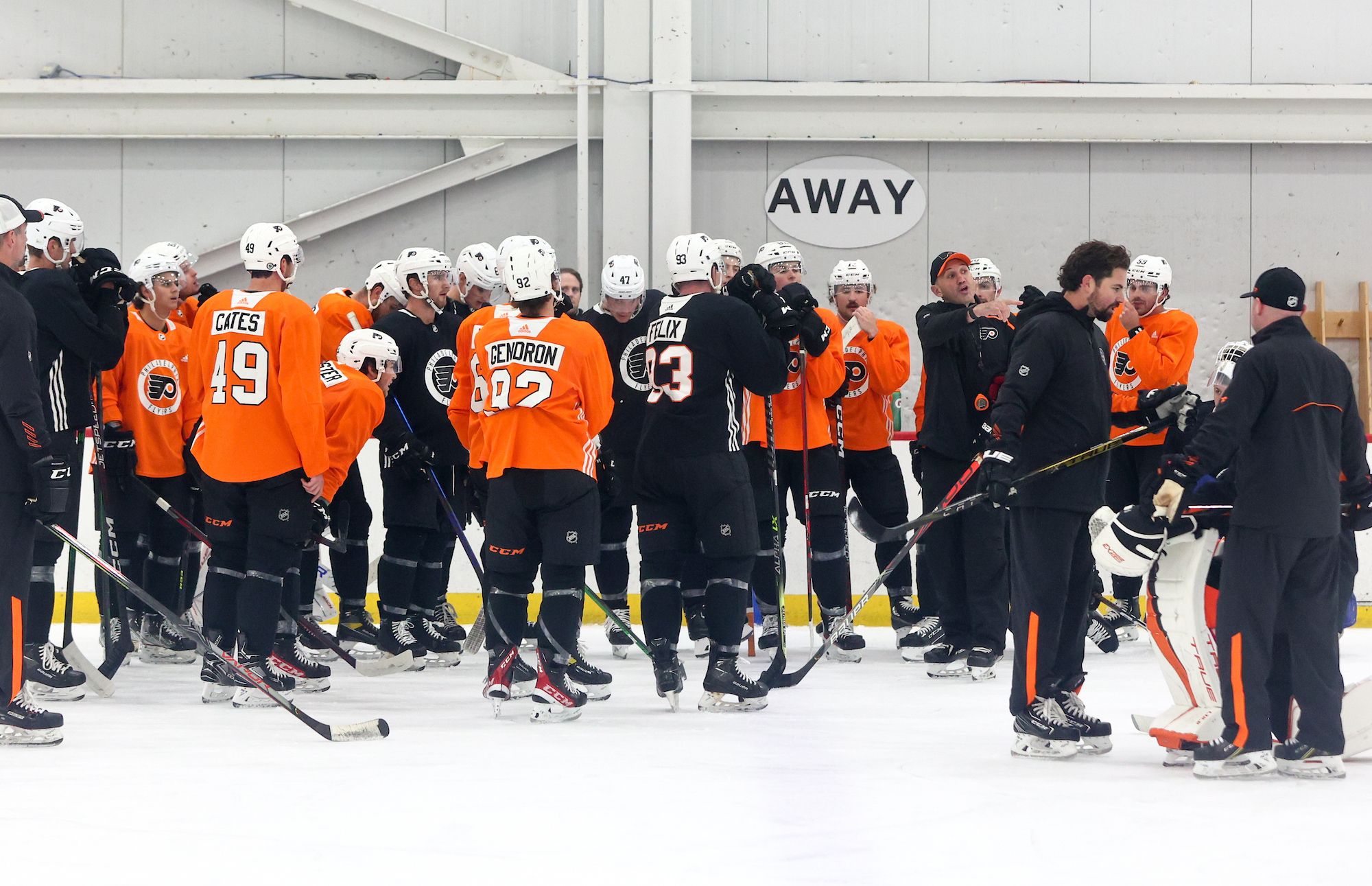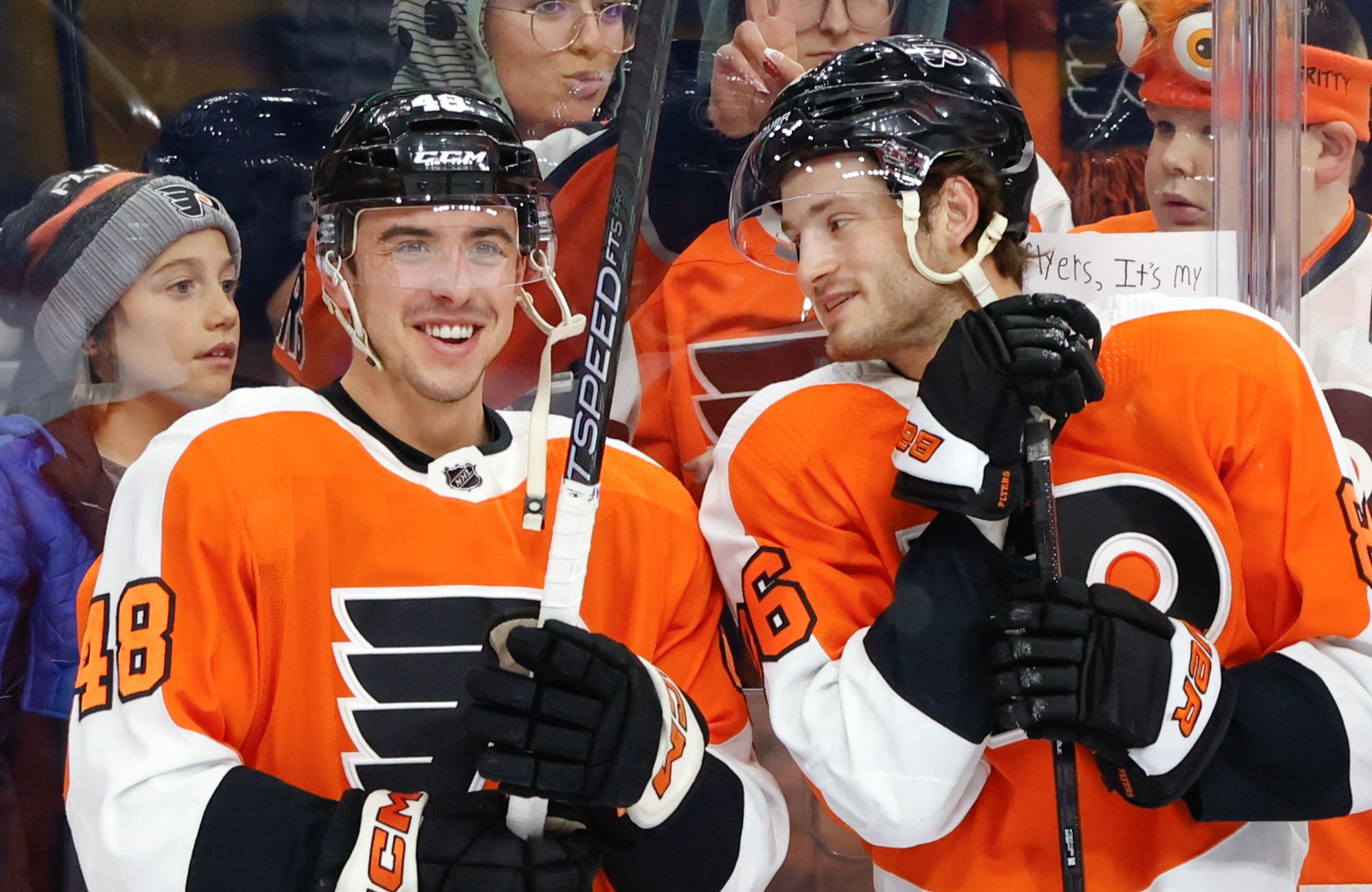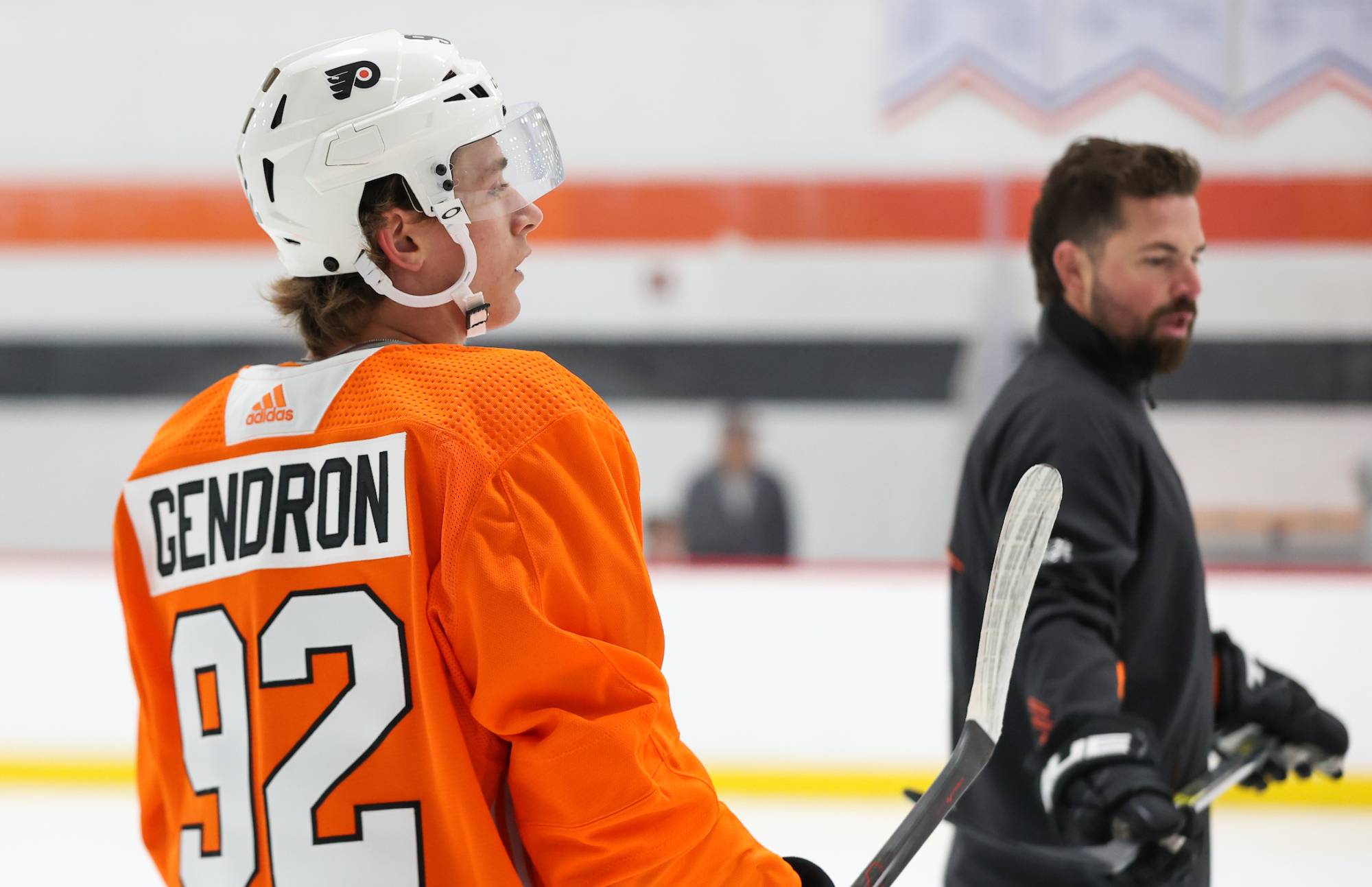Morning Observations is a feature where we break down the previous night’s game with an analytical eye.
#1: Players felt they just got the bounces this time
Following the game, the general consensus from the Flyers’ locker room was that the team’s performance against the Avalanche was not so different from the team’s play over the preceding three weeks, when they posted a 2-6-0 record. Instead, members of the Flyers’ leadership core like Claude Giroux, Wayne Simmonds and Jakub Voracek all primarily attributed last night’s 4-0 domination of Colorado to better execution on their shots and just plain better luck, not dramatically different underlying processes. Simmonds in particular spoke not like a player relieved or satisfied, but isntead annoyed that this game had been elevated to the status of a “must-win” due to the team’s poor recent results.
The players aren’t wrong that they’ve done a lot of things right over the past three weeks. Over that eight-game stretch, Philadelphia posted a score-adjusted Corsi at 5v5 of 53.14% and an xG rate of 50.64%, but were able to score on just 3.11% of their shots at 5-on-5. That does speak to an element of misfortune causing the recent struggles. Last night, the Flyers again held the territorial edge at 5v5 (52.47% SA-Corsi) but finally got an even strength goal and were helped by revitalized special teams, which chipped in for three goals of its own. The process was the same as it’s been recently at 5v5 and on the PP — blast away from the point, get traffic in front and try to make life difficult on opposing goalies. It’s just that this time, that plan actually worked.
#2: Colorado is really, really bad
As the 2016-17 season has progressed, the Flyers’ biggest issues have become clear. For starters, while the team generally wins the raw territorial battle at even strength, their propensity for low quality shots results in a deflated shooting percentage. In addition, goaltending has been downright horrific, giving the Flyers one of the league’s worst goal differentials at 5v5. There are some positives in their statistical profile (a stellar shot generation PP, a decent PK, and the aforementioned solid raw differentials at 5v5) which have kept the team from ranking among the league’s worst on the whole, but there are obvious flaws.
However, the Colorado Avalanche make the Flyers look like a Cup contender. Basically, take everything bad about the Flyers (shot quality, goaltending, luck) and you’ll find Colorado is right there with the orange and black. Philadelphia’s Expected 5v5 Fenwick shooting percentage is 5.39% (28th in the NHL) and their actual is 4.36% (30th); the Avs check in at 5.18% (30th) and 4.46% (29th) respectively. Flyers goalies had stopped 89.39% of all the shots they faced (29th in the NHL) entering last night, and Colorado was right with them at 89.80% (27th). As for luck, Philadelphia held what would have been the worst full-season PDO of any NHL team in a non-lockout shortened year since 2007 at 96.94, but Colorado wasn’t far behind at 97.12. Basically, these two teams have the same statistical issues. The difference between them is that the Avs even grade out poorly where the Flyers are strong. Colorado’s score-adjusted 5v5 shot differential is an atrocious 45.75%, and don’t forget that this is a team that also has shot quality issues. Finally, instead of having one of the league’s best shot generation PPs, Colorado has one of the worst, ranking 29th in shot attempts per 60 at 5v4.
Basically, it’s tough to find a single area where Colorado grades out even okay. They have all of the Flyers’ flaws, and then about five other major weaknesses as well. That’s why even though it was nice to see Philadelphia get back into the win column with a comfortable victory, the competition couldn’t have been weaker.
NHL.com Report & Highlights | Corsica.Hockey Game Recap Page | HockeyStats.ca Recap | NaturalStatTrick Recap | HockeyViz.com | BSH Recap | Meltzer’s Musings
#3: Simmonds continues strong goal scoring year
There’s a reason why every single “blow it up!” comment or post always seems to note that Wayne Simmonds would be the one guy that the Flyers need to retain. That’s completely irrational (if you’re going to trade Giroux and Voracek and your team isn’t competing for at least the next two years, why keep a player whose great contract only spans those two years of non-competition?) but it’s obvious why people are willing to make an exception for the Wayne Train. That’s because he’s been the only player this season who has reliably delivered the universally-accepted fun event in a hockey game for the Flyers — goal scoring. With his two-goal night against Colorado, Simmonds now has 27 on the season, just five behind his career-high of 32. If he holds to his current pace, Simmonds will crack the 35-goal mark by the end of the year.
It hasn’t been a perfect season for Simmonds — his play-driving results at 5v5 (-4.2% CF%RelTM, -4.33% score-adjusted Corsi Rel) have regressed after a strong 2015-16, but it’s hard to nitpick too much considering his scoring prowess. The only disappointing part about Simmonds’ game last night was that he did not actually score a hat trick, even if the fans in the arena assumed he would be credited with the team’s third goal of the night and threw their hats as a result. Jake Voracek (who did score the goal) joked after the game, “I hope some fans won’t throw rocks at my car when I’m going home.” Despite the fans’ obvious love of the Wayne Train, my guess is that Voracek’s car was still safe. That blowout win ensured that.
#4: How do we evaluate Jordan Weal?
In the best moment of the night, Jordan Weal scored his first NHL goal (and his first NHL point) on a well-executed deflection of a Radko Gudas point shot. Weal has now played in five games this year with the Flyers and has stood out in a positive way in three of them (he was largely invisible versus Pittsburgh and barely played against the Oilers before getting hurt), which is a better ratio than that of the vast majority of Flyers’ players. But I’m not sure we’ve come anywhere close to answering the Jordan Weal question, despite his quick start.
Against San Jose and Calgary, Weal impressed me because his physical skillset seemed to be dramatically improved versus what he showed in limited games with the Flyers in 2015-16. Not only was Weal holding his own in board battles, his acceleration also appeared more sudden and effective. However, Weal has appeared (to my eyes) to slow a bit since returning from the injury. He’s still far better than he was last year in physical battles — Hakstol referred to him as a “puck-possession player” in his post-game press conference — but he’s settling back into his old skating speed baseline very quickly. Weal’s hockey sense (especially offensively) appears to be strong, but for a guy with his size, I’d like to see better skating ability. In any case, Weal has played well enough to stick with the team even after Travis Konecny is ready to return, simply for auditioning purposes. I’d like for the Flyers to know exactly what they have in Weal before making a decision on his future — I just don’t think we have quite enough information yet to do so at this point.
#5: MacDonald was actually good
Credit Andrew MacDonald for coming through with one of his more effective games of the season last night. Not only did MacDonald actually drive play at 5v5 (59.08% score-adjusted Corsi), he legitimately helped in creating dangerous offense as well. His passing and puck carrying ability was on display from the start of the game, and he even kickstarted the shorthanded rush that ended with Simmonds’ first tally of the game.
While MacDonald’s passive neutral zone defense is ever-present, his puck-moving ability is better described as inconsistent rather than nonexistent. As a result, MacDonald is fully capable of games where he can play the role of offense-driving defenseman. Last night was one of those instances, and it was a pleasant surprise.
#6: Mason the forgotten man returns
For some reason, the Flyers’ coaching staff chose to ride goaltender Michal Neuvirth in February to the tune of nine starts in ten games, despite the fact that his play steadily declined as the month progressed. It all came to a head this past Saturday in Pittsburgh, as Neuvirth killed any chance of a Philadelphia third period comeback by allowing two especially weak goals at Heinz Field. That apparently was the last straw, as Steve Mason was back in net for last night’s game, his first start since February 9th and only his second of the month.
Mason quickly justified the coach’s decision to give him the nod. Despite facing 33 shots, Mason pitched a shutout, holding down the fort even as the Avs generated a total of 3.50 Expected Goals across all situations. The Flyers’ netminder was at his best in the second period, after the team in front of him sagged a bit in the wake of Jordan Weal’s goal that extended their lead to four. Colorado took 17 shots in the period and created 11 regular scoring chances, but could not dent Mason, who kept the game out of reach long enough for the skaters to rediscover sound, two-way hockey in the final session.
#7: MDZ outplayed Streit
There’s talk that a goaltender (probably Neuvirth) could be moved prior to the 3PM trade deadline, but the two most likely trade pieces on the Flyers are defensemen — Mark Streit and Michael Del Zotto. Both are pending unrestricted free agents, and neither have an obvious place in the Flyers’ future: Streit because of his age (39), and Del Zotto because of his poor 2016-17 season. Streit would seemingly generate more demand, as he has been a lineup staple all year for the Flyers (Del Zotto has been scratched repeatedly), has solid scoring rates (20 points in 48 games), and still has a good reputation around the league as a power play option.
However, in last night’s game, Del Zotto looked like the better defenseman. Not only did he lead by the advanced metrics (50.85% score-adjusted Corsi for MDZ to 46.25% for Streit), Del Zotto was consistently making noticeable plays all night long while Streit was struggling with easy ones. Specifically, Del Zotto looked especially strong when dealing with puck pressure, using his size to ward off checkers. Streit’s most memorable moment, however, was an especially egregious defensive zone turnover that required a huge save by Mason in the second period. I assume that Streit is still more likely to get moved today, but one player helped his case and it wasn’t the wily veteran.
#8: Zone entries are always challenged
One difference between the Flyers and their opponents over the past week that has become very obvious to me is in zone entry defense. Teams like Washington, Pittsburgh, and even Colorado (for all their faults) have speedy, dangerous forwards up front, which results in opposing defensemen allowing them space for clean entries into the offensive zone in order to avoid being burned. That gives them more space to create dangerous passing plays off the rush, as well. The Flyers’ forwards, on the other hand, don’t seem to be treated with the same respect.
Aside from Voracek, no other forward on Philadelphia right now seems to inspire consistent fear on the rush, which makes almost every controlled entry a chore to watch, since the forwards have very little space from the second they cross the blue line. That’s not to say that the Flyers allow more controlled entries than they create — per Corey’s tracking, the respective rates are around even. But my guess is that opponents create far more scoring chances off rushes than the Flyers do on theirs. Unfortunately, there’s no easy solution here, aside from simply adding more dynamic forward talent up front, and obviously they don’t grow on trees. But it’s something I’m going to watch more closely the remainder of the year to see if I can quantify what my eyes tell me is an issue.
#9: Weal-Giroux-Simmonds the team’s best line at 5v5
Captain Claude Giroux may not have improved his 5-on-5 rate scoring last night, but his two assist game (both coming on the PP) was his first multi-point effort since January 14th in Boston. In addition, it wasn’t as if Giroux did not help to create offense at even strength. In fact, his line (flanked by Jordan Weal and Wayne Simmonds) was the team’s most productive at 5v5 last night, with all three forwards delivering score-adjusted Corsi rates above 67% and Weal himself scoring a goal. The line even exceeded 75% in terms of xG, so they also dominated the shot quality battle as well. All in all, it was a solid night for the captain, who truly looked the part of a 1C in this one.
#10: The Flyers should still sell if possible
Last night’s 4-0 win on trade deadline eve should not have dramatically changed the thought processes of the Flyers’ front office. After all, Colorado is legitimately the worst team in the NHL, and a victory against them is more an expectation rather than a major triumph. Even with the two points that Philadelphia added to their total (they’re now at 65) last night, they remain four points behind Toronto with one more game played. That may not seem like much, but considering the loser point’s existence and the amount of teams in the race for that final spot, the team’s playoff chances are very slim.
If they can pick up draft picks in the first three rounds for a player like Mark Streit, or mid-to-late rounders for guys like Del Zotto or Neuvirth, I’d hope that Ron Hextall isn’t afraid to pull the trigger. Not only will more picks aid in the reloading of the team’s pipeline, there’s also the simple fact that losing any of the rumored players to a trade will not kill any chance of a late season surge. Mark Streit is useful, but if the Flyers get on a run fueled by shooting percentages finally swinging wildly in their direction, it will be guys like Giroux, Voracek and Gostisbehere that lead the way and not Mark Streit. Del Zotto has been a regular scratch. Mason is a better goalie than Neuvirth and should be starting the majority of games anyway.
The idea that Hextall should draw a line in the sand and say “meet my asking price or else” only makes sense if you believe that the Flyers “rental” players are essential to the team engineering a surprise playoff berth, which I believe to be a questionable stance. The focus today, in my opinion, should be on acquiring as many assets as possible, partially for the draft and partially to collect possible currency for pre-expansion draft deals. Brandon Davidson is a perfect example of the latter – a useful second pair defenseman traded last night for an expiring contract because Edmonton knows they won’t be protecting him. A few more mid-round picks in Hextall’s hands makes it a lot easier to justify trading for an attractive blueliner in June that a team can’t protect. There will be guys like that out there — Josh Manson of Anaheim comes to mind immediately as a possibility — and the more picks you have, the easier that type of trade becomes to finalize.









